|
|
Post by sheshki on Jul 24, 2013 18:18:54 GMT -5
Hello Blocksterz, the Ugaritic cuneiform script was inspired by the Sumerian/Akkadian cuneiform and was developed around the 14th century BCE, nearly 1500 years after the appearance of cuneiform. www.omniglot.com/writing/ugaritic.htmHere is a quote from wikipedia that sums it up: The original Sumerian script was adapted for the writing of the Akkadian, Eblaite, Elamite, Hittite, Luwian, Hattic, Hurrian, and Urartian languages, and it inspired the Ugaritic and Old Persian alphabets.I never had a look into Ugarit cuneiform, but now i will.  |
|
|
|
Post by sheshki on Jul 24, 2013 18:52:08 GMT -5
The first word of your text mīšaram is written across the first line.     It is MI-SHA-RA-AM The second line on the inscription is I-NA MA-TIM, which transliterates into ina mātim, the second and third word from your text.  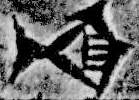   ...and so on. Hope that helps. I´ll have a look if i can find clearer images for the signs. Like for example this MA  It is from a slightly older inscription (between 300 and 400 years), but looks the same. |
|
argileye
dubsartur (junior scribe)

Posts: 5
|
Post by argileye on Jul 25, 2013 7:40:57 GMT -5
OK, so after some research, I managed to locate the fragment on the actual stele. Correct me if I'm wrong, but it seems that each line being rotated 90 degrees clockwise, means that the columns are read right to left (I made the attached image to illustrate this point). Now I am struggling to find a transliterated version of the inscription using a TrueType font. That's because certain characters are quite difficult to figure out. Particularly, the last one of the forth line. I am thinking of getting the tattoo on the right side of my rib cage (I know, painful...) and I want it as accurate as possible if not identical to the inscription on the stele. I will get it in the first week of September, most likely as I will be away abroad during August and I want to work with a particular tattoo artist back home. Once I get it, I'll make sure to post some pictures. Thank you again guys for your help in this matter, particularly sheshki. Attachments:
|
|
|
|
Post by sheshki on Jul 25, 2013 11:29:39 GMT -5
Well, yes, on the statue the columns are read from right to left, and if you view it that way the single columns are read top to bottom, because, like i pointed out in the previous post, the first line (or in the 90° version the column to the right) consists of 4 signs, MI, ŠA, RA, AM, and they do form the first word of the transliteration "mīšaram" It is of course up to you if you get it tattooed in the 90° turned version, but if you ever meet someone who can read it his/her neck will hurt or you have to lay down that he/she can read the text without injuring his/her neck  I personally would get it tattooed in the version you posted first, so that you can read the single lines from left to right. Oh and here is the actual cdli entry for the stele www.cdli.ucla.edu/P249253Your text starts at line 32. The difficult sign you mentioned is NAM. 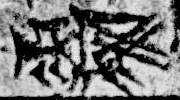  And last but not least, here is a signlist. The signs are a bit more "modern" than the ones used on the stele, you will see it when you look up NAM. etcsl.orinst.ox.ac.uk/edition2/signlist.phpHope that helps.  |
|
|
|
Post by us4-he2-gal2 on Jul 26, 2013 19:14:29 GMT -5
Yes, Sheshki has it right when he says: "I think the reason why it was vertical on the stele itself is that the very old inscriptions of the Sumerians were written that way...at some point they turned their signs 90°. And it was very chique to write like the ancient Sumerians did  They also used a kinda archaic form of the signs for the inscription. This was very common for royal inscriptions. I hope i got that right." Here is a comment from Martha Roth, an expert who edited the text of the Hammurabi Stele in 1995. She says about the Louvre stele (the Hammurabi Stele): "The physically imposing Louvre stela, like other monumental inscriptions of its time, is inscribed in an archaic ductus and in the direction employed earlier, before the script was turned ninety degrees counter- clockwise; the visual impact of the script and the orientation, along with the archaizing, literary language used in the prologue and epilogue that frame the collection of rules, magnify the authority of the composition." So to put this in different words, in very old Sumerian texts, cuneiform was originally read top to bottom - likewise in the Hammurabi stele, it is read top to bottom. In very old Sumerian, the cuneiform signs originally had a different alignment, 90 degrees clockwise to what is the standard of cuneiform in other ages. Likewise, the signs on the Hammurabi stele are 90 degrees cloakwise to what is 'standard orientation' for cuneiform of its age. The cuneiform signs changed their alignment in the Sumerian era, and texts began to be written left to right (just as we write). The reasons for these changes are unknown. The elite scribes of Hammurabi's era circa 1900 BC were Babylonian, as the Babylonians had taken over southern Iraq from the older Sumerian culture. But these elite Babylonian scribes were keenly aware of the debt owed to Sumerian culture, as the Babylonians inherited the scribal and intellectual traditions of the Sumerians, embracing them completely. No Babylonian scribe was respectable who could not read and write in Sumerian. And as Martha Roth (and Sheshki) note, the execution of the Stele inscriptions in the oldest archaic style script added authority and tradition to the overall presentation. As for the question of why was your original text going in the usually direction and the usual orientation, this is likely a scholars adaptation modified to run the way modern scholars are used to seeing cuneiform. To capture the nuance of the text form, that it presents itself as the law precedents written in a textual tradition of far distant days (far distant even at the time of Hammurabi), I would have the tattoo down true to the stele - just as it is in your attached picture above  You've been very astute and capable handling assyriological materials which are often troublesome and confusing even to people who work with them. Feel free to ask anything about Mesopotamia or these laws etc. Hope you will check back also when tattoo pics are available. Best of luck! |
|
|
|
Post by sheshki on Aug 13, 2013 5:46:17 GMT -5
A new tattoo is in the making. It is a line i found at ETCSL, From Inanna and Andnun-gal-e-ne dirig-ba ki-sikil dinana za3-mi2-zu mah-am3Because you are unmatched among the Great Princes, maiden Inana, praising you is magnificent! 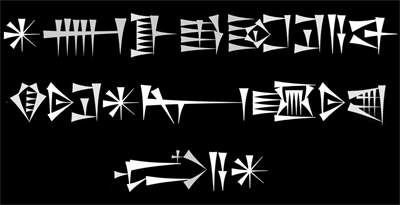 |
|
|
|
Post by us4-he2-gal2 on Aug 21, 2013 14:19:10 GMT -5
Nice plan Sheshki  lots of nice signs there, I'd say NUN is my favorite. Well you will have to see if there is still room somewhere for that - Even Gudea will have to be jealous of that level of inscription I suppose. This year I have to learn Sumerian cuneiform.. Question becomes, to start with early or archaic signs, which are fun, of OB (which may be more sensible? ) |
|
|
|
Post by enkur on Aug 24, 2013 7:29:07 GMT -5
I think it's best to learn the archaic pictograms together with their later cuneiform signs, which are in fact their stenographic inscriptions, that one may feel how the latter derive from the former...
|
|
|
|
Post by sheshki on Sept 25, 2013 10:15:01 GMT -5
It is done! 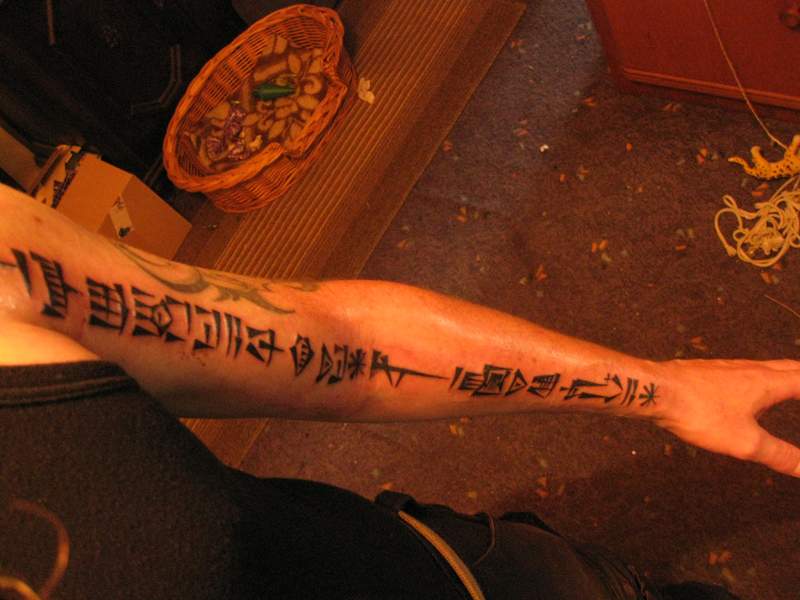 |
|
|
|
Post by ummia-inim-gina on Sept 25, 2013 12:43:45 GMT -5
Wow, that is awesome! Gudea would be jealous indeed. Very impressive tattoos my friend. It looks as if that was all done in one session. How long did that take to get done?
|
|
|
|
Post by enkur on Sept 26, 2013 5:27:58 GMT -5
Great! I use this as a mantra to greet the Evening Star whenever I see Her during the recent months.
|
|
|
|
Post by us4-he2-gal2 on Sept 30, 2013 17:10:06 GMT -5
Very nice man!  I have only for signs tattooed currently, en2-e2-nu-ru, and so you are pulling even further ahead. I like the DINGIR.INANNA on the inner elbow, I'm sure that way painful though! |
|
|
|
Post by sheshki on Jan 14, 2014 17:18:49 GMT -5
This years birthday cake, including sumerian inscription  1. {d}Inanna 1. {d}InannaTo Inanna 2. dingir-ra-niher goddess 3. an-da-re-aAndrea 4. nin muhaldimMistress of the kitchen 5. nam-tifor the life 6. dam shesh-kiof her spouse Sheshki 7. nam-tifor the life 8. dumu nin-e2-galof her child Ninegal (which is our kitten) 9. a-mu-rushe created it. 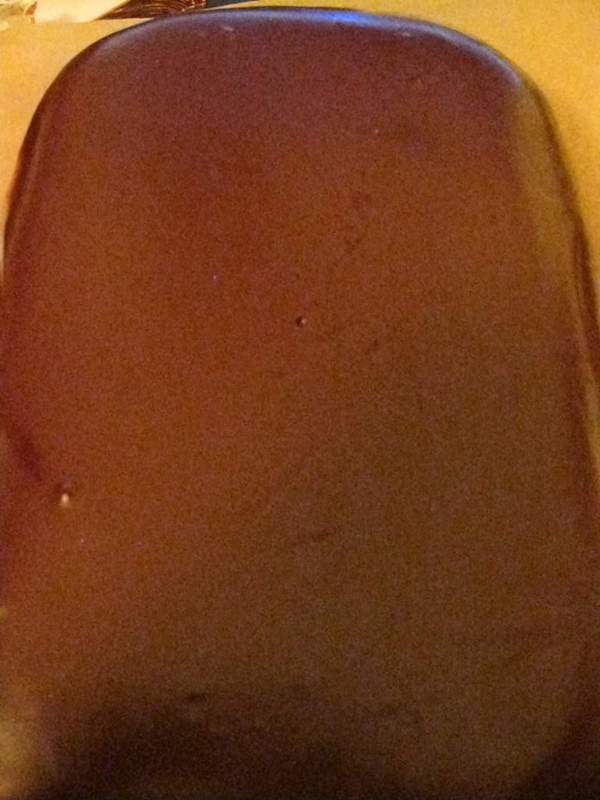 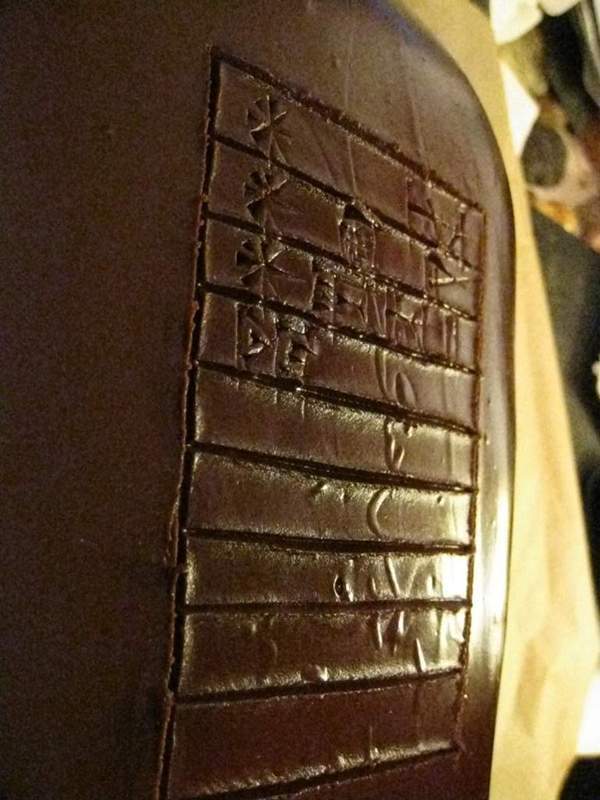 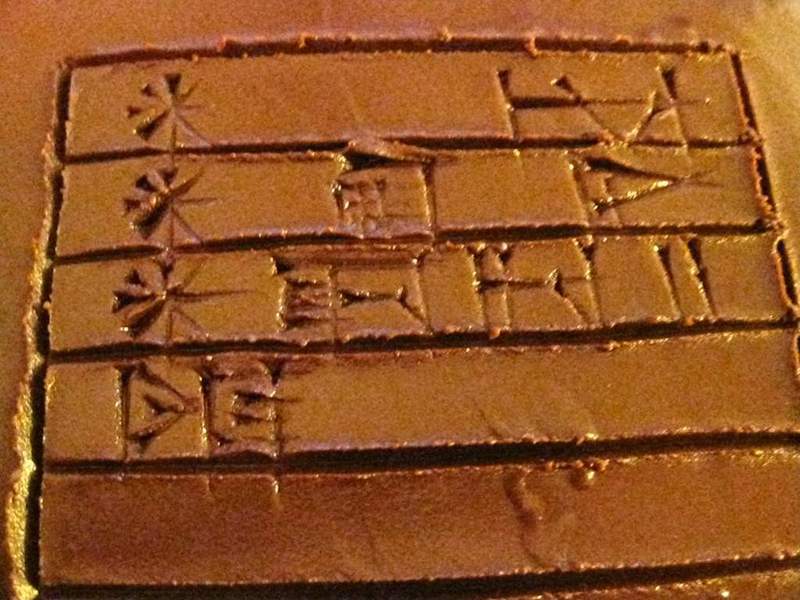 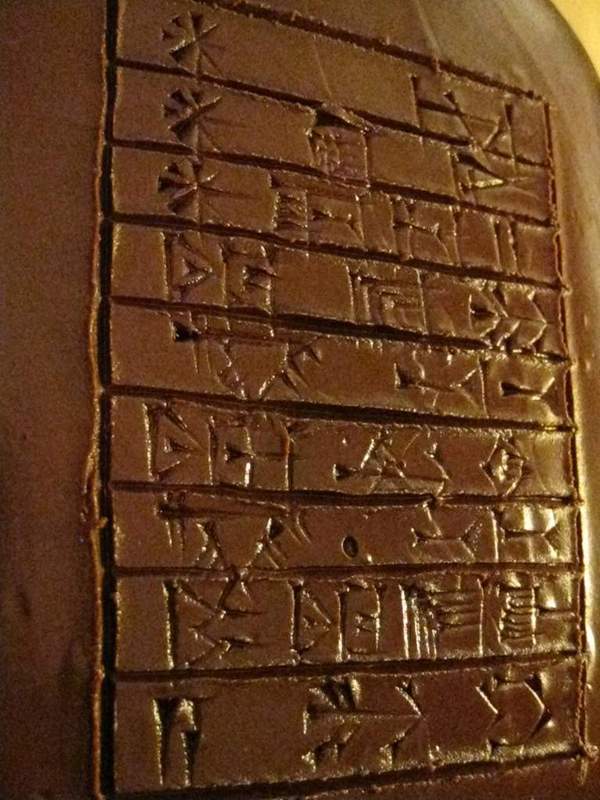 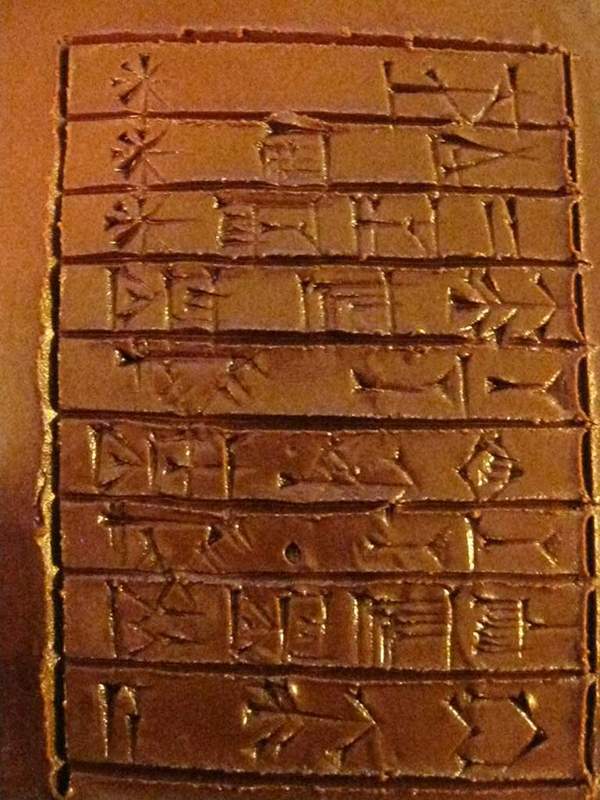 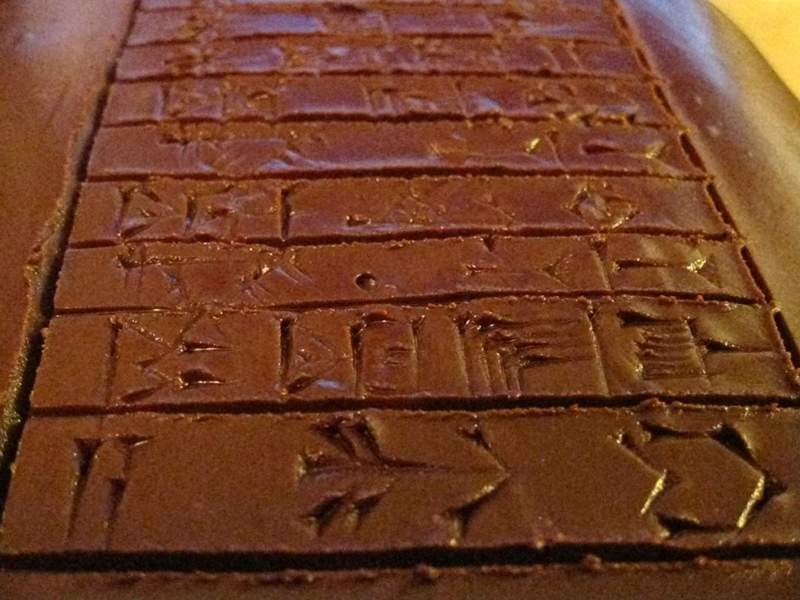 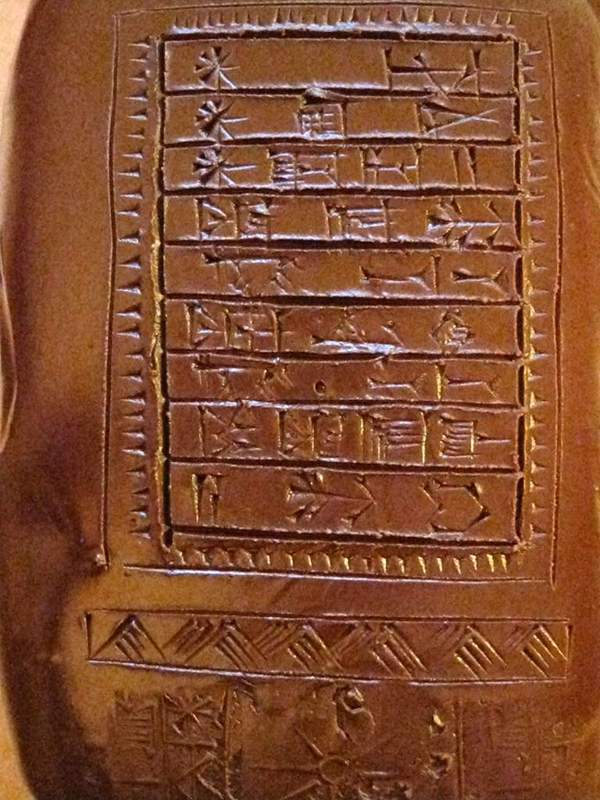 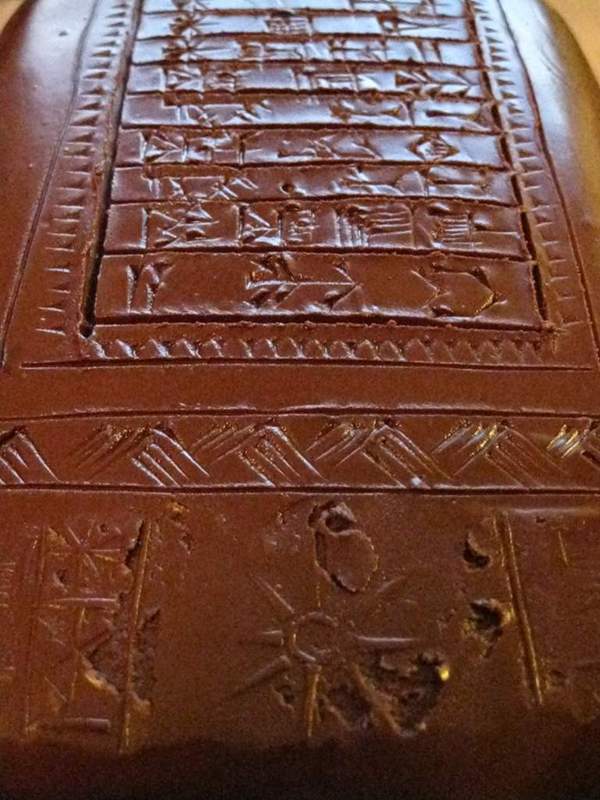 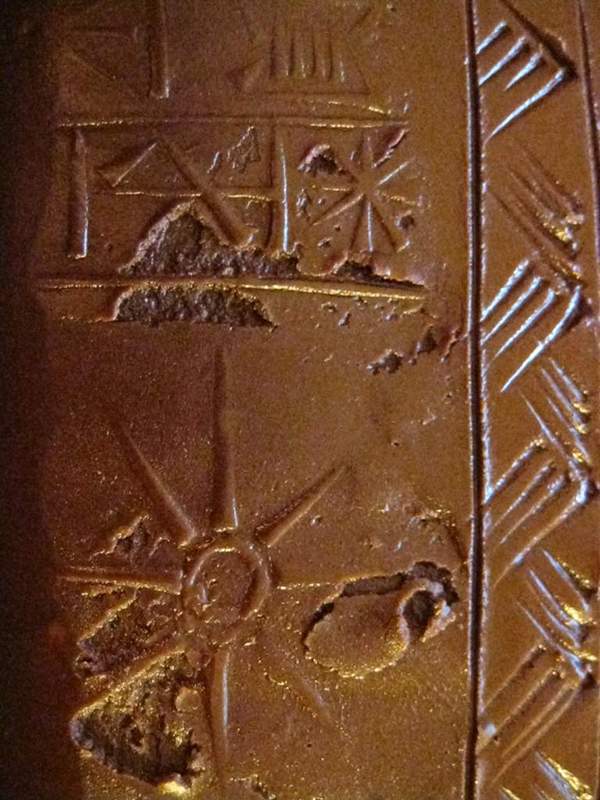 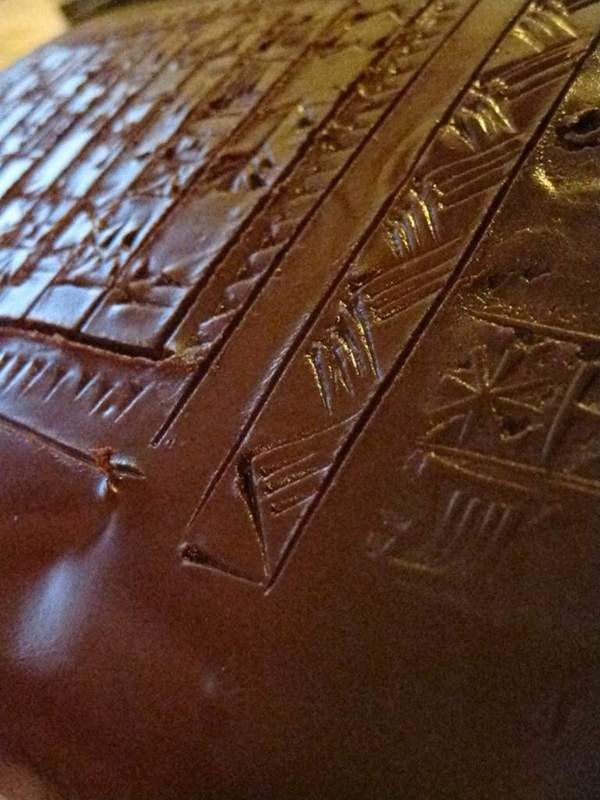 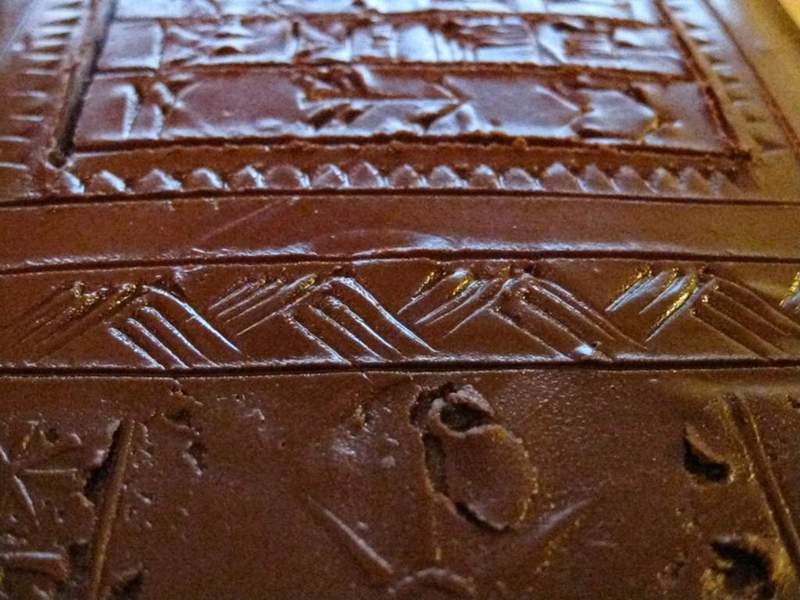 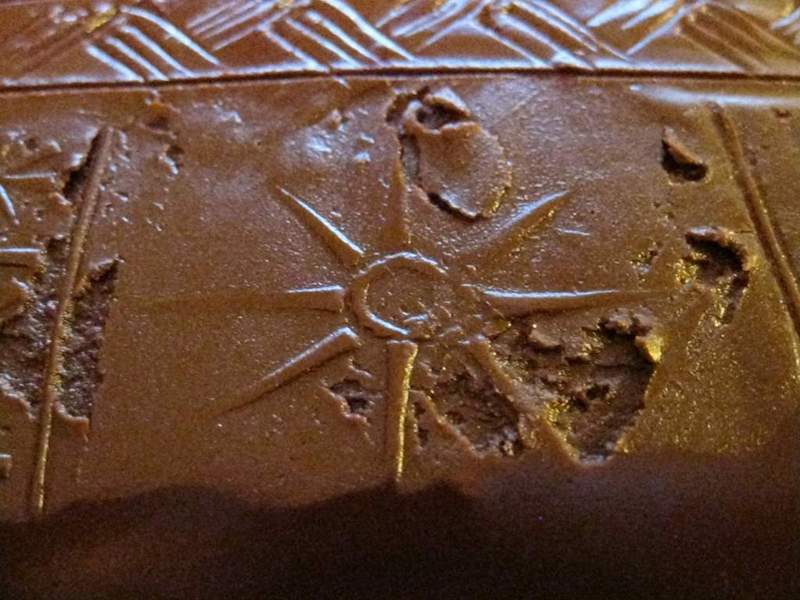 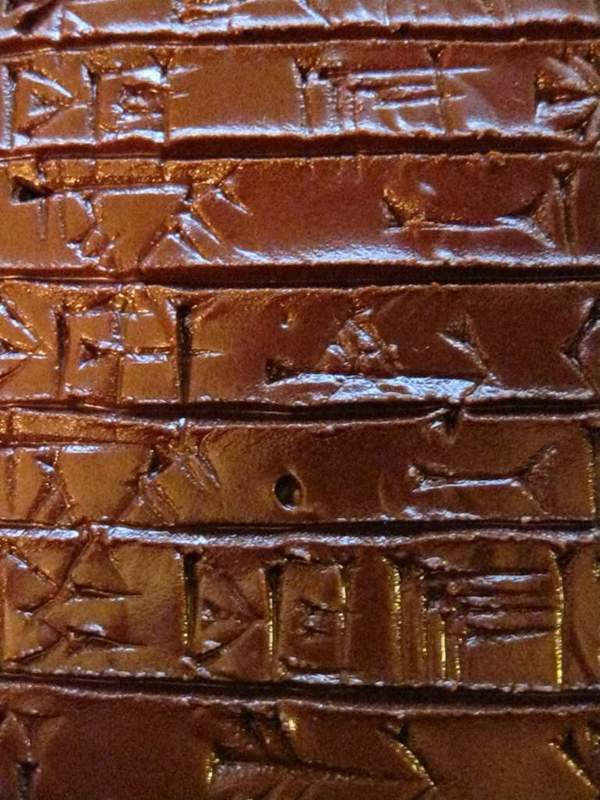 Chocolate cake is mighty!  |
|
|
|
Post by us4-he2-gal2 on Jan 14, 2014 21:08:08 GMT -5
Wow - now that is a b-day cake!  Must have one steady hand to inscribe a cake like that. I love the 8-pointed star! |
|
|
|
Post by enkur on Feb 3, 2014 19:03:28 GMT -5
|
|
|
|
Post by sheshki on Feb 4, 2014 13:17:05 GMT -5
According to R. Borger´s Mesopotamisches Zeichenlexikon gala 7 is IG    Let me know if there are other signs i can help you with. |
|
|
|
Post by enkur on Feb 4, 2014 18:23:47 GMT -5
Thank you very much, Sheshki! I even suspected it could be IG but wasn't sure, having only the ETCSL signlist and the ePSD at my disposal. So now I'm trying to guess if u in line 11 (u-me-sikil etc.) is u3 (IGI.DIB or U3 according to Borger). Also, I wonder if em in line 12 (he-em-ta-gub) is em x (A.AN) or EN? (he being he2 for sure) What do you think?
|
|
|
|
Post by enkur on Feb 5, 2014 9:46:32 GMT -5
I'm also interested in identifying the sign $a in the line 3:kur-$a-ta, translated as "deep in the mountain" which should be rather "from the heart of the mountain" ("ta" being "from"), if $a is $a3 (heart) - or maybe just $a psd.museum.upenn.edu/epsd/psl/img/popup/Odle.png which equals $a3 ($ag4)? It's difficult for me to recognize the old Sumerian signs in that stenographic Babylonian way of inscribing them. I've noticed also that outside of the ETCSL, not all the authors are so precise in their transliterations as regards the sign numbers. |
|
|
|
Post by sheshki on Feb 5, 2014 10:14:28 GMT -5
Thank you very much, Sheshki! I even suspected it could be IG but wasn't sure, having only the ETCSL signlist and the ePSD at my disposal. So now I'm trying to guess if u in line 11 (u-me-sikil etc.) is u3 (IGI.DIB or U3 according to Borger). Also, I wonder if em in line 12 (he-em-ta-gub) is em x (A.AN) or EN? (he being he2 for sure) What do you think? I wrote it out according to the transliteration. Line 11 is U 3. EM in line 12 is IM. Line 3 is ša 3. Btw, in transliteration you distinguish between i.e. šá (ša 2) and šà (ša 3) Hope that helps. If something is unclear in my scribble tell me. 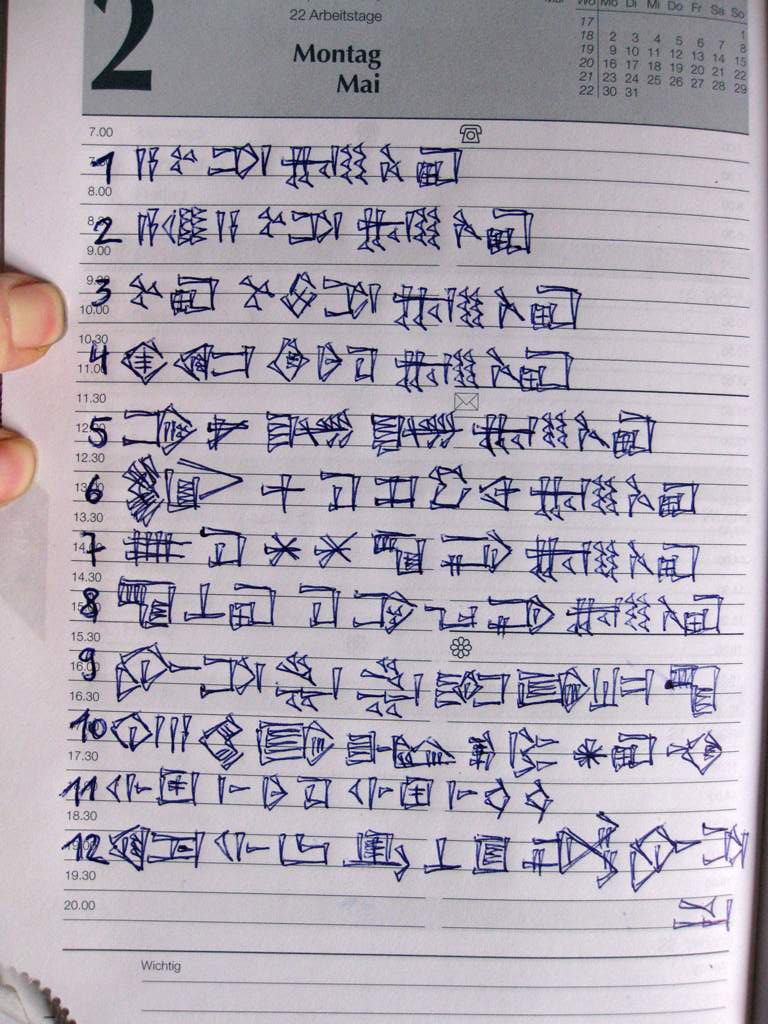 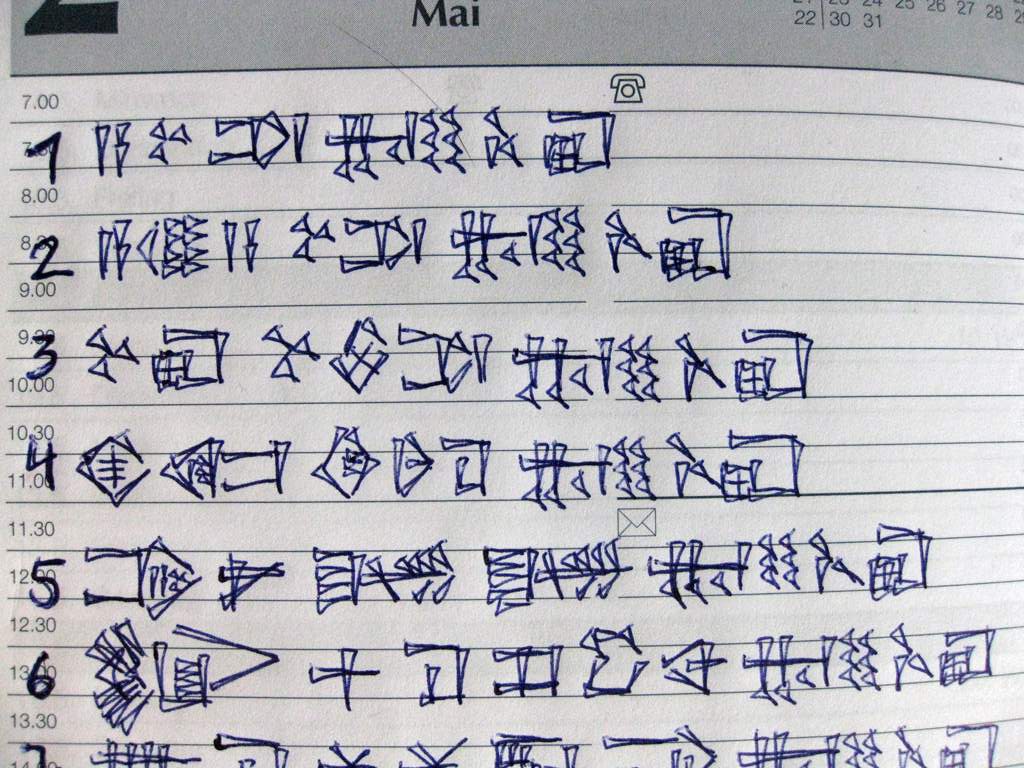 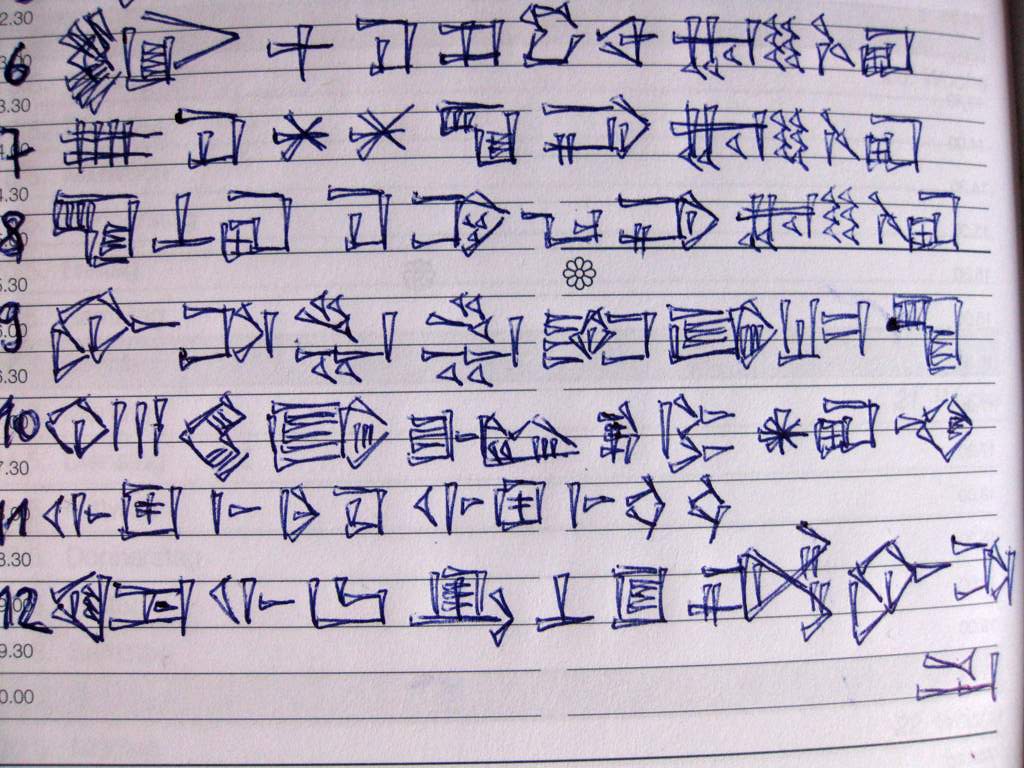 |
|
|
|
Post by enkur on Feb 5, 2014 17:50:06 GMT -5
That's really great on your part writing to me the entire text. Great thanks, Sheshki!
So now I can see I have been on the right track for many points while trying to identify the signs by the Babylonian stenographic writing and its transliteration.That's encouraging indeed.
Btw $a2 is unknown to me. $a I wrote instead of $a3 is given as having the same meaning as $a3 in the ePSD.
|
|
|
|
Post by enkur on Feb 5, 2014 19:01:58 GMT -5
|
|
|
|
Post by enkur on Feb 5, 2014 19:08:07 GMT -5
Below is written "Confirmed by Sheshki" as regards IG. Now everything is corrected. This was informative only. Attachments:
|
|
|
|
Post by us4-he2-gal2 on Feb 16, 2014 10:18:56 GMT -5
Very nice Enkur and Sheshki. This incantation, YBC 5639, is extent in an Old Babylonian copy, but is known to have been in use since at least Ur III times. It seems specifically designed for the purification of the king, and this is interesting as 2 incantations from the Ur III period are now known which make specific reference to two kings by name: see Ur III incantations thread, Jul 8 2007. I have just noticed that CDLI does offer a line drawing of the tablet in question: CDLI entry P306706. But drawing this from transliteration is good exercise!  I think you guys have done great here, and the signs do correspond to the CDLI line drawing. Sometimes they look different but of course this has to do with scribal conventions of period and locality. For example, take the ku 3 sign on line 10 - while both of you have rendered the ku 3 as it appears in the Old Babylonian Sumerian sign convention, in CDLI line drawing it appears in perhaps slightly later form as used by Akkadian scribes of Babylonia. But of course, this doesn't really matter, both are (of course) the ku 3 sign. My attachment below is taken from Labat, and you can see the wide variety of this sign, even within a relatively short period of time. Attachments:
|
|
ajvan
What post button?
Posts: 4 
|
Post by ajvan on Mar 5, 2014 13:02:41 GMT -5
![]() Started to learn a cuneiform not long ago, and I have found a great dictionary, but I cant find there names of Gods, Goddesses and Demons. Could you please, guys, write here, how to write with cuneiform names of Tiamat, Pazuzu and Asag? |
|
|
|
Post by sheshki on Mar 5, 2014 16:58:27 GMT -5
Pazuzu and Tiamat in Neo Assyrian script. 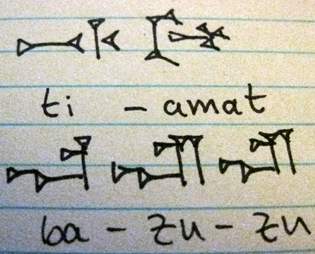 ![]() Started to learn a cuneiform not long ago, and I have found a great dictionary, but I cant find there names of Gods, Goddesses and Demons. Could you please, guys, write here, how to write with cuneiform names of Tiamat, Pazuzu and Asag? |
|
ajvan
What post button?
Posts: 4 
|
Post by ajvan on Mar 6, 2014 4:20:09 GMT -5
Oh, I see now, thanxsssss)  But I've got a new question. So, if in ''Tiamat'' the first sign, represented like ''ti'' has only a phonemic function, then ''amat'' is written with some logographic sign? |
|
|
|
Post by us4-he2-gal2 on Mar 6, 2014 5:58:12 GMT -5
Well interestingly, this sign is both a logogram and a sign with just a phonetic value. I use Labat's signlist called "Manuel D'Epigraphie Akkadienne" to find these values, it is entry #558. As a logogram, the sign is (in Sumerian) GEME2 which is in Akkadian amtum. Both carry the meaning "female slave." In fact, the sign itself represents this visually, and combines the sign for female (MI2) with the sign for mountain or foreign land (KUR). The historical significance here is that when a hostile or rebellious group were defeated militarily, the early Mesopotamians would generally slaughter the male population (or blind them for slave service) and enslave the women and children. Thus a foreign woman in early Mesopotamia was usually an amtum In certain usages amtum is rendered amat.
With the writing of Tiamat's name, the sign is not being used logographically, but phonetically. That is, the scribes knew the sign could make a word with the sound 'amat' and so they simply use the sign to render the desired sound. In this use of the sign has nothing to do with female slaves, in the same way that a monkey has nothing to do (necessarily) with a key..or a monk.
|
|
ajvan
What post button?
Posts: 4 
|
Post by ajvan on Mar 6, 2014 9:43:52 GMT -5
Wow, awesome explanation.
So I see, here is just the Chinese concept of building characters and writing the names
|
|
pizzewis
dubsartur (junior scribe)

Posts: 7
|
Post by pizzewis on Apr 26, 2014 11:33:03 GMT -5
Since everyone is so anxious to see my tattoo...
Here you go! Took me a lot of time, eventhough it seems simple.
Presenting Sheshki's cat!

No the first thing isn't...

EDIT: With a special thank you for Sheshki('s cat)! |
|
|
|
Post by us4-he2-gal2 on Apr 27, 2014 19:49:09 GMT -5
Hey Pizzewis: Very nice! That's a great looking cuneiform tattoo  Nice thick black lines wonderful execution. Well, looks like it says d.Nin-e-gal to me (I think Sheshki gave me a hint already, but also I know dingir and nin and gal - and e but not in this period of cuneiform.) Well you have joined a small but growing number of people who have got cuneiform tattoos and posted them here on enenuru, for reasons inexplicable to most of society - I'm going to have to create a tattoo sub-board at this rate 0_0 |
|